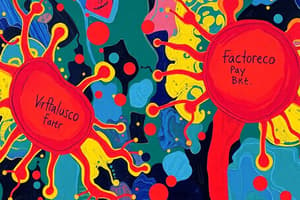Podcast
Questions and Answers
Which structural feature of staphylococci interferes with opsonization and subsequent phagocytosis?
Which structural feature of staphylococci interferes with opsonization and subsequent phagocytosis?
- Capsular polysaccharide (correct)
- Teichoic acids
- Protein A
- Coagulase
What is an important indicator of pathogenicity in staphylococci?
What is an important indicator of pathogenicity in staphylococci?
- Production of coagulase (correct)
- DNase activity
- Protein A production
- Fibronectin binding
Which factor may facilitate bacterial attachment to tissues damaged by toxic factors elaborated by staphylococci?
Which factor may facilitate bacterial attachment to tissues damaged by toxic factors elaborated by staphylococci?
- DNase activity
- Protein A
- Staphylococcal cell wall proteins (correct)
- Fibronectin binding
Which virulence factor of S. aureus is plasmid or phage-mediated?
Which virulence factor of S. aureus is plasmid or phage-mediated?
What may predispose to the development of staphylococcal infection?
What may predispose to the development of staphylococcal infection?
Which factor produced by staphylococci interferes with opsonization and subsequent phagocytosis?
Which factor produced by staphylococci interferes with opsonization and subsequent phagocytosis?
Which marker for pathogenicity is an important indicator of pathogenicity in staphylococci?
Which marker for pathogenicity is an important indicator of pathogenicity in staphylococci?
Which virulence factor of S. aureus may facilitate bacterial attachment to damaged tissues?
Which virulence factor of S. aureus may facilitate bacterial attachment to damaged tissues?
Which type of factors are most of the virulence factors encoded in the staphylococcal genome?
Which type of factors are most of the virulence factors encoded in the staphylococcal genome?
Which structural feature of staphylococci binds to fibronectin and fibrinogen, facilitating bacterial attachment to tissues?
Which structural feature of staphylococci binds to fibronectin and fibrinogen, facilitating bacterial attachment to tissues?
Flashcards are hidden until you start studying
Study Notes
Staphylococcal Infections
- The presence of a capsule in staphylococci interferes with opsonization and subsequent phagocytosis.
- The production of coagulase is an important indicator of pathogenicity in staphylococci.
- The binding of bacterial surface components to fibronectin and fibrinogen facilitates bacterial attachment to tissues damaged by toxic factors.
- The virulence factor of S.aureus, enterotoxin, is plasmid or phage-mediated.
- The presence of damaged tissues, for example, those caused by toxic factors, may predispose to the development of staphylococcal infection.
- The production of the polysaccharide capsule interferes with opsonization and subsequent phagocytosis.
- Coagulase is a marker for pathogenicity and is an important indicator of pathogenicity in staphylococci.
- The binding of bacterial surface components to fibronectin and fibrinogen facilitates bacterial attachment to damaged tissues.
- Most of the virulence factors in staphylococci are encoded in the genome as chromosomal genes.
- The surface component of staphylococci that binds to fibronectin and fibrinogen is the polysaccharide capsule.
Studying That Suits You
Use AI to generate personalized quizzes and flashcards to suit your learning preferences.






